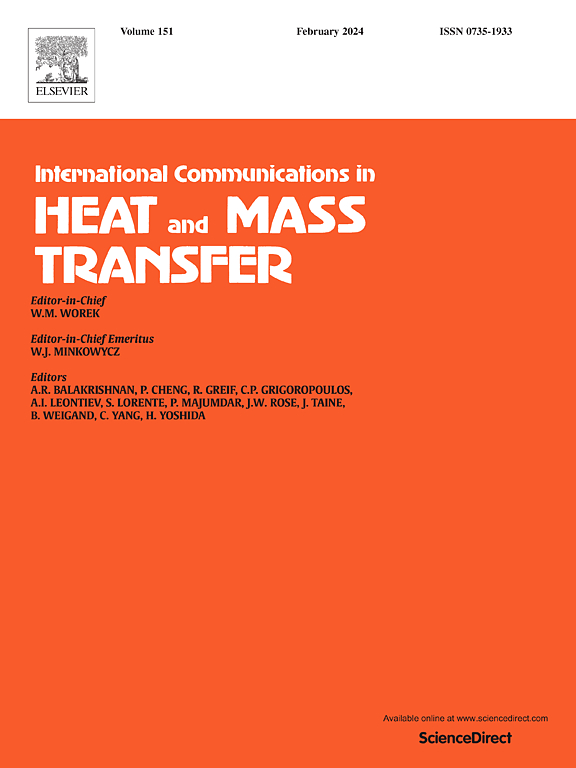具有各种几何形状和尺寸通道的紧凑型热交换器中的传热强化
IF 6.4
2区 工程技术
Q1 MECHANICS
International Communications in Heat and Mass Transfer
Pub Date : 2025-06-28
DOI:10.1016/j.icheatmasstransfer.2025.109273
引用次数: 0
摘要
在保持热交换器性能的同时减小其尺寸和质量的需求要求紧凑型热交换器(CHEs)的发展。它得到了加工工业对增加热能回收的额外推动的支持,在严格限制空间、材料和成本的情况下,促进了加工工厂更好的能源效率。在相同的工艺条件下,用热交换器充分替代传统热交换器需要保持相同的热负荷,不超过允许的压力损失。分析了提高换热器密实度的不同途径,包括改变换热器通道的水力直径,以及通过改变通道的几何形状和流动结构来采用各种强化传热的方法。在现有文献资料的基础上,比较了板式换热器平面管、强化管和通道的努塞尔数和摩擦系数相关性。开发了一种新形式的堆芯速度方程,可以比较在特定工艺条件下采用不同增强技术和不同尺度的CHE加热表面的性能。计算结果说明了换热强化通道的水力直径和长度对CHE热工性能的影响。根据特定的工艺条件和水流性质,提出了选择最佳通道几何形状和尺寸的建议。本文章由计算机程序翻译,如有差异,请以英文原文为准。
Heat transfer intensification in compact heat exchangers with channels of various geometries and size
The need to decrease the sizes and masses of heat exchangers while preserving their performance has stipulated the development in compact heat exchangers (CHEs). It is supported by the additional push from process industries for increased recuperation of heat energy, facilitating better energy efficiency in process plants with strict limitations for space, material and cost. The adequate substitution of conventional heat exchangers by CHE in the same process conditions requires maintaining the same heat load not exceeding the allowable pressure losses. The different ways to increase the compactness of CHE are analysed, including the change of hydraulic diameter of heat exchanger channels, and the use of various methods of heat transfer intensification by changing channel geometry and flow structure. The Nusselt numbers and friction factors correlations for plane tubes, enhanced tubes and channels of plate heat exchangers are compared based on available literature data. A newer form of the core velocity equation is developed, which allows a comparison of the performance of CHE heating surfaces with different enhancement techniques and varying scales in specific process conditions. The results of the calculations illustrate the influence of the channel's hydraulic diameter and length on CHE thermal and hydraulic performance for channels with heat transfer intensification. The recommendations on choosing the best channel geometry and size, depending on specified process conditions and stream nature, are formulated.
求助全文
通过发布文献求助,成功后即可免费获取论文全文。
去求助
来源期刊
CiteScore
11.00
自引率
10.00%
发文量
648
审稿时长
32 days
期刊介绍:
International Communications in Heat and Mass Transfer serves as a world forum for the rapid dissemination of new ideas, new measurement techniques, preliminary findings of ongoing investigations, discussions, and criticisms in the field of heat and mass transfer. Two types of manuscript will be considered for publication: communications (short reports of new work or discussions of work which has already been published) and summaries (abstracts of reports, theses or manuscripts which are too long for publication in full). Together with its companion publication, International Journal of Heat and Mass Transfer, with which it shares the same Board of Editors, this journal is read by research workers and engineers throughout the world.

 求助内容:
求助内容: 应助结果提醒方式:
应助结果提醒方式:


